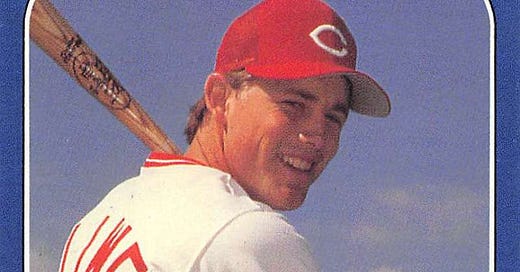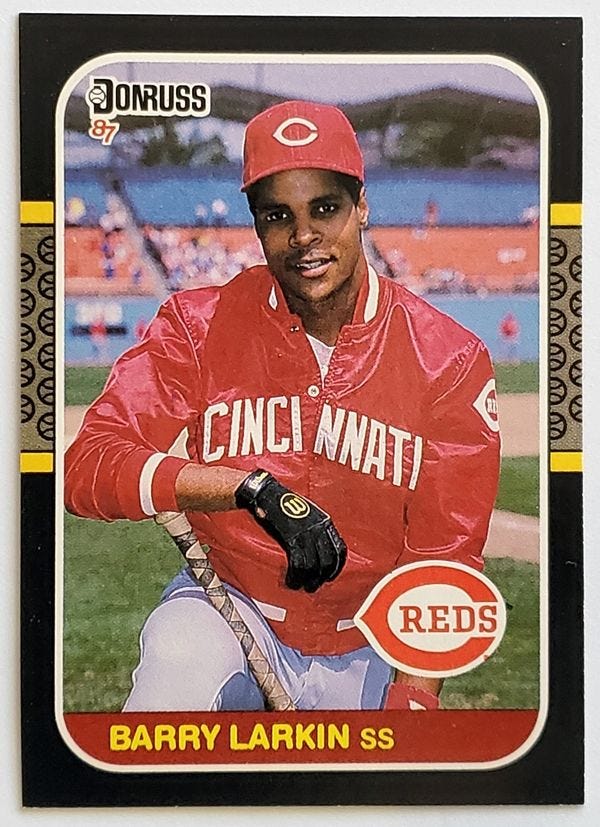Barry Larkin v. Kurt Stillwell
The positional battle of the last century, now largely forgotten
In recent months, there has been much hand-wringing over upcoming positional battles among key young Reds players. Where will Elly De La Cruz end up defensively? What about Matt McLain? How does Jonathan India fit into the lineup next year, and the year after? Who will be forced to change positions? Will Spencer Steer end up in the outfield full-time? Will Christian Encarnacion-Strand be strictly a designated hitter? And where does franchise legend Joey Votto figure into this conversation?
This conversation reminds me of something. If you’ll allow me to wax poetic about this glorious game of baseball for a moment…
These positional battles often make for a compelling narrative, not necessarily of stark opposition, but of shared trajectories, mirrored aspirations, and lives intertwined by common ambitions and hurdles. You can make the argument that India and McLain are fighting for the same thing, but that doesn’t make them adversaries, right?
That was the reality for Barry Larkin and Kurt Stillwell, two talented players vying for the same position on the Cincinnati Reds roster during the mid- to late-1980s. They found themselves embroiled in a competition, not specifically against one another, but rather against a shared goal, aiming for a singular dream: to secure the Reds’ starting shortstop position. Larkin and Stillwell weren’t enemies, but their destinies were so closely tied together that the tale of one cannot be separated from the other.
Barry Larkin was a Cincinnati native, born in 1964, his journey deeply rooted in the local baseball diamonds where he nurtured a gift that eventually would etch his name into the annals of baseball history. A distinguished college career at the University of Michigan honed his abilities. The Reds noticed, and in 1985, made him their first-round pick in the MLB Draft. A promising prospect, a child of the city — that’s a story that writes itself.
Kurt Stillwell’s tale was no less enchanting. Born just a year later, in 1965, this California kid traded sunny beaches for baseball diamonds. The sunny shores of California, where he sharpened his skills, starkly contrasted with Larkin's Midwestern upbringing. A high school phenom, Stillwell didn’t take the college route but found himself selected by the Reds in the first round of the 1983 MLB Draft, a full two years before Larkin. His path seemed clear, his star was on the rise, and the Reds had invested in his future.
But destiny has a way of complicating matters. Larkin and Stillwell were about to be thrust into a rivalry that would define their early careers. Stillwell made his big league debut in April of 1986, and Larkin followed four months later. By 1987, the question hung in the air at Riverfront Stadium: who would be the Reds’ shortstop of the future? The answer seems obvious in retrospect, but it was not at the time.
Further, this isn’t only a tale merely of two prodigious talents, but also of the waning years of Dave Concepcion, a living legend in the Queen City, and an instrumental cog of the revered Big Red Machine. With his twilight years approaching, the question could be better framed: Who would be Davey’s successor? And was it time for him to step aside?
Baseball, like all sports, is a game of comparisons. At the time, Larkin was seen as the more reliable at the plate, his swing both smooth and efficient, his batting eye sharp. Stillwell was thought to be the superior fielder, his glove as reliable as a Swiss timepiece, his arm strong and accurate. Two sides of the same coin, each demonstrating the different skills that define a shortstop’s role.
Spring training in 1987 was a battleground, though one wouldn’t know from the quiet professionalism of Larkin and Stillwell. The Florida sun bore down on them, each groundball fielded and every pitch swung at scrutinized. Theirs was not a rivalry marked by animosity, but by shared respect. The diamond was their arena, the crack of the bat their discourse, the smooth arc of a well-fielded ball their dialogue.
In February, just as spring camp was kicking off, Reds manager Pete Rose weighed in, in the pages of The Sporting News:
If Barry Larkin is certain he will be the Cincinnati Reds’ shortstop, said Manager Pete Rose, he had better look over his shoulder. Standing there is 21-year-old Kurt Stillwell, who won a spot on the roster last spring while Larkin remained at Denver (American Association). “I go by the latest thing I see,” said Rose. “And I remember that Stillwell played very well in September. If Stillwell has another spring like he did last year, he could very well be our shortstop.” Larkin, 22, was summoned from Denver in mid-August and hit .283 in 159 at-bats. Stillwell closed strongly and finished at .229 in 279 at-bats. There was late-season talk that one of the two might switch to second base, but Rose closed that off with, “Larkin doesn’t want to play second base and Stillwell can’t. Besides, Ron Oester is my second baseman.”
Is Dave Concepcion in the shortstop race? “Davey knows his role,” Rose said. “We re-signed him as a utility player. He’ll play first base, second base, shortstop, third base, and outfield… If Davey goes to spring training and stands around at shortstop, he’ll be approaching it all wrong.”
As the 1987 season rolled on, the Reds gave both players ample playing time. Larkin played in 125 games, Stillwell in 131. It was a period of observation and evaluation, a year-long audition for the role of a lifetime.
The '87 season presented both players with equal opportunities to impress. The year unfolded like an audition, a performance under the watchful eyes of Reds' management. Larkin narrowly won the initial competition after what local scribe Hal McCoy (in the May 11, 1987 issue of The Sporting News) called “a spirited but friendly spring argument.” Rose named Barry the starter, but Stillwell got another chance very soon. Larkin hyperextended his left knee in a collision with San Diego’s Stan Jefferson on April 12. Stillwell started the next 14 games, batting .327 and adding in his first big league homer, a grand slam in a 9-8 Reds victory over Houston.
When Larkin was eligible to return to the roster, the Reds appeared to be in no hurry. “There is no rush,” said general manager Bill Bergesch. “We can wait until Barry is completely healthy. Kurt is playing well and does not deserve to come out of the lineup.”
When Larkin did return, Reds fans were restless. According to McCoy:
With the success of the two young shortstops, some fans in Cincinnati are booing veteran second baseman Ron Oester and demanding on radio talk shows that the Reds trade him and install Stillwell at second base.
“I hate it when they boo Ronnie,” Stillwell said. “It’s pretty uncalled for. He is doing a great job. And although I’d like to be in the lineup, I’d like to play shortstop.”
Asked if he wanted to be traded so he could play shortstop, Stillwell was adamant: “No. I like Cincinnati,” he said. “I feel a powerhouse is in the makings here and I want to be part of it. It’s fun to win.”
When the dust settled on the season, Larkin had hit .244/.306/.371 (76 OPS+) and made 19 errors; Stillwell posted a slash line of .258/.316/.375 (80 OPS+) with 18 errors. The difference, in the end, was slim. Yet, when dealing with the future of a franchise, even the slimmest of margins can become defining chasms. The Reds’ decision did, in fact, come in the form of a trade. Stillwell was sent to the Kansas City Royals after the 1987 season. The die had been cast. The Reds had chosen Larkin as their shortstop for the foreseeable future.
The immediate aftermath saw Stillwell thrive in his new surroundings, with Kansas City offering him the opportunity to step out from Larkin’s imposing shadow. The Pacific Coast kid now had the chance to display his ability unencumbered by the comparisons that had been inevitable in Cincinnati. He quickly found his footing, as the 1988 season saw him named to the All-Star team.
Meanwhile, back in Cincinnati, Larkin continued his steady progress, further consolidating his position as the Reds’ primary shortstop and earning his first All-Star selection in 1988, as well. It seemed both players had benefited from their separation. The career paths of Larkin and Stillwell were shaping up to be not a tale of one victor, but rather of two athletes flourishing in their own environments.
However, as the years wore on, the wisdom of the Reds’ decision became increasingly evident. Larkin’s skills sharpened over time, his blend of agility, strength, and baseball acumen pushing him to the forefront of baseball’s elite. His abilities only grew more impressive with time. His potent blend of offense, defense, and leadership formed the fulcrum of a highly successful Reds team.
Even today, he echoes of this decision reverberate through Reds history. Over a 19-year career, all spent with the Reds, he amassed accolade after accolade: a 12-time All-Star, a three-time Gold Glove winner, and the 1995 National League MVP. In 2012, the doors of the Baseball Hall of Fame swung open to welcome him.
Meanwhile, Stillwell crafted a solid, respectable career, though one filled with fewer glories. After a few seasons with the Royals, he journeyed on to the San Diego Padres and the Anaheim Angels before his retirement in 1996. While he never quite reached the heights that Larkin did, his dependable glove work and consistent batting (at least for a shortstop in the 1980s and 90s) allowed him to carve out a decent big league career.
It’s worthwhile to consider what may have transpired had the decision gone the other way. Stillwell, who seemed poised for a remarkable career, may have seized his chance in Cincinnati and written his own legendary tale. But baseball, much like the world it reflects, is not governed by ‘what ifs’, but by actions, decisions, and the unerring trajectory of a pitch, the unflinching path of a well-hit ball. The Reds chose Larkin, and he proved them right.
I’m reminded of the story of Barry Larkin and Kurt Stillwell when I encounter arguments about the current crop of young stars in Cincinnati. Will Reds’ management make the correct choices? I don’t know. We’ll look back in thirty years and be able to judge these decisions.
But this situation, and the Larkin/Stillwell battle, remind me of the unknown, of the enduring and enigmatic allure of baseball. The beauty of this game lies not solely in the scoreboards or record books, but also in the human dramas – the hopes and the dreams, the successes and the failures – that unfold both on and off the diamond.
Yes, I love every single thing about this game.






Great article, Chad! I definitely remember that competition and imagined a battle like that with our SS candidates like Barrero, McLain and EDLC. I hope that the Reds find a trade partner for Barrero. He definitely deserves a shot at a starter for another team!